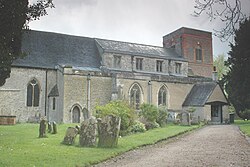Brightwell-cum-Sotwell
| Brightwell-cum-Sotwell | |
| Berkshire | |
|---|---|
 St Agatha's parish church | |
| Location | |
| Grid reference: | SU5890 |
| Location: | 51°37’8"N, 1°9’47"W |
| Data | |
| Population: | 1,530 (2001) |
| Post town: | Wallingford |
| Postcode: | OX10 |
| Dialling code: | 01491 |
| Local Government | |
| Council: | South Oxfordshire |
| Parliamentary constituency: |
Wantage |
| Website: | Brightwell-cum-Sotwell Website |
Brightwell-cum-Sotwell is a twin-village and civil parish in northern Berkshire. It lies between Didcot to the west and the historic market town of Wallingford to the east.
Brightwell-cum-Sotwell were originally two separate villages, rural settlements whose inhabitants worked the land.
History
The ramparts on Wittenham Clumps provide enduring evidence of Iron Age settlement in the area. The Romans were here later; the road from Dorchester on Thames to Calleva Atrebatum is believed to have passed along what is now the Mere and Mackney Lane.
Mediæval times
The first written evidence of a village here comes from the various Anglo-Saxon charters describing ownership of land in Beorhtanville, Suttanwille and Maccanie. In the Domesday Book of 1086, it is recorded that there were 70 families and two mills in Brightwell and Sotwell, but where these stood and how they were powered is unknown.
Within 50 years of Domesday, Brightwell Castle was involved in the civil war between King Stephen and his cousin Matilda. The exact site of this castle is unknown, but it probably lay within the moated areas of what later contained St Agatha's/Brightwell manor house in Brightwell or Stonor Hayes manor house in Sotwell.
Early modern times
For the next 800 years Brightwell and Sotwell parishes only occasionally appear in recorded history. For example:
- 1500 (circa) [Prince Arthur (eldest son of Henry VII) stayed at Sotwell House.
- 1507 Clerk in Holy Orders murdered in St Agatha's.
- 1649 Edward Hyde DD ejected from his living for being a Royalist.
- 1666 Church collection for victims of the Great Fire of London.
- 1726 Mrs Frances Riggins leaves a legacy "for bread and ye schooling for ye poor of Slade End".
- 1774-1849 Reverend Thomas Wintle. "About 4 o'clock with my neighbours at ye Red Lion where they dined at the expense of ye parish and myself and then set again to mark the boundaries"
- 1781 King George III rode through the village returning from a stag hunt.
- 1785 A Sunday school set up by the Reverend Wintle.
- 1811 Inclosure Act for Brightwell.
With the coming of the Industrial Revolution and the Victorian era, the village had some significant philanthropists who worked hard for the good of the villagers:
- Reverend Marmaduke Thompson - building of Brightwell National School in the village.
- Reverend John Haldane Stewart - building of the new village school, which is now the village hall. Forming a night school for adult parishioners.
- Farmer Edward Fairthorne - Reading Room and recreation ground for the villagers. Scholarships for promising boys to go to Wallingford Grammar School.
- Miss Augusta Fairthorne - endowment of the Free Church.
Modern times
The War Memorial records the loss of villagers in the armed services in two world wars. In the second half of the 20th century there was significant expansion of the villages and in 1948 the villages of Brightwell and Sotwell were brought together as one civil parish. In 1949 the Greenmere estate was built and later, estates were also built at Kings Orchard, Monks Mead and Datchet Green.
There are no immediate plans for any major development.
Notable buildings and structures
A walk around the narrow village streets will reveal many houses still standing which date back to Tudor times and beyond. The oldest building is probably Woodleys (Old Nursery Lane), with other examples such as Dobson's (Sotwell Street), The Old Priory (Little Lane), Middle Farm and Abbots House (both Church Lane - formerly Great Lane) and Smalls House (Mackney).
The parish churches of St Agatha (Brightwell) and St James (Sotwell) would have been at the centre of village affairs, surrounded by many thatched cottages with cob, or wattle and daub, walls.
Gallery
-
The Red Lion public house
-
Inside St. Agatha's parish church
-
Moat Cottage and K6 telephone box
Outside links
| ("Wikimedia Commons" has material about Brightwell-cum-Sotwell) |
- Royal Berkshire History: Brightwell-cum-Sotwell
- Brightwell-cum-Sotwell Website
- Dr Edward Bach Centre
References
Further reading
- Page, W.H.; Ditchfield, P.H., eds (1924). A History of the County of Berkshire, Volume 4. Victoria County History. pp. 464–471; 507–511.
- Pevsner, Nikolaus (1966). Berkshire. The Buildings of England. Harmondsworth: Penguin Books. pp. 102–103; 221–222.



